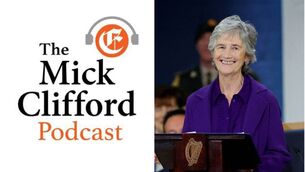Orla Kelleher: Does 2050 climate strategy give enough detail on how Ireland will reach net-zero?

The delayed draft climate action strategy was only published after litigation was threatened by Friends of the Irish Environment and the European Commission.
A long-term strategy, it is a decarbonisation plan with a 30-year perspective. It should be the centrepiece of the Government’s climate mitigation policy.
It is meant to be the roadmap out to 2050, setting out in detail how the State is planning to achieve its target of being a “climate-resilient, biodiversity-rich, environmentally-sustainable, and climate-neutral” economy by 2050 at the latest.
The recently-published draft long-term strategy is more than three years late. Under EU law, the Government should have submitted such a long-term strategy on January 1, 2020.
The Government delayed publishing its strategy to ensure it aligned with its new 2021 Climate Act. Regrettably, the draft strategy was continuously delayed and was only published after litigation was threatened by both Friends of the Irish Environment and the European Commission.
CLIMATE & SUSTAINABILITY HUB
A public consultation on the draft long-term strategy, which is required by law, is to be launched shortly.
Under both EU and Irish climate law, the Government must produce a long-term strategy that among other things must specify, or provide sufficient detail, on how Ireland will pursue and achieve its 2050 target of climate neutrality or net-zero emissions.

A net-zero target contains two related but different responses to global warming. It involves reducing emissions, but also removing carbon dioxide from the atmosphere through natural sinks (such as forests and
peatlands) and negative emissions technologies (such as carbon capture and storage).
Negative emissions technologies are controversial. The Intergovernmental Panel on Climate Change has warned that an extensive deployment of these technologies is “subject to multiple feasibility and sustainability constraints”.
The risks include that removals will be seen as a substitute for deep and immediate emission reductions; that the carbon could still leak back into the atmosphere; that these technologies will lead to heightened competition for land; and that as many of the technologies are prospective they may not work at scale.
The 2021 Climate Act also imposes a new obligation on the environment minister and the Government that they must act in a manner consistent with the 1.5C/well below 2C temperature goal of the Paris Agreement when making climate plans.
In ‘Climate Case Ireland,’ the Supreme Court quashed Ireland’s first climate plan because it did not provide sufficient detail on how the Government would meet its 2050 target.
According to the Supreme Court, the test for a compliant decarbonisation plan is whether a reasonable and interested member of the public could know enough about how the Government intends to achieve the 2050 target from reading it, to decide if the Government’s policies were “effective and appropriate”.
Not having a long-term strategy in place is, in the words of Ireland’s Climate Change Advisory Council, “a critical gap” in Ireland’s climate policy approach. Ireland needs a credible but ambitious long-term strategy in order to ensure investment in the economy does not become locked in to stranded assets and high-emissions activities.
So how does the draft long-term strategy measure up and does it provide us with enough information on how
Ireland can achieve its 2050 climate target? Does it commit to significant and sustained emissions reductions in the coming decades or is it pinning its hopes on the availability of vast negative emissions technologies?
The answer remains unclear. The draft strategy contains a lot more qualitative information (about the types of policies and measures Ireland should pursue) rather than quantitative information (how much of each type of policy or measure will be needed to decarbonise). The draft long-term strategy recognises that achieving climate neutrality will require Ireland’s carbon dioxide emissions from fossil- fuel energy use in power generation, heating, industry, and transport to reduce to effectively zero.
Remaining emissions from agriculture will require removals to reach climate neutrality by 2050. In the absence of more quantitative information in the draft long-term strategy though, it is difficult for “reasonable and interested members of the public” to assess whether the Government’s proposed policies and measures are “appropriate and effective”.
The draft does make reference to the development of a strategy for negative emissions technologies.
However, it does not provide a date by which such a strategy will be prepared.
One way to ensure reliance on negative emissions technologies does not delay emissions cuts would be to include a minimum target in the long-term strategy for how much of the net-zero target must be achieved through actual emissions reductions.
The Dutch have taken this approach within their long-term strategy, which stipulates that the Netherlands will
reduce its emissions by 95% by 2050 compared to 1990. This emissions reduction target has also been enshrined in the country’s climate law and represents one of the highest emission-reduction targets of EU member states.
The upcoming public consultation on the long-term strategy is a major opportunity for the Government to build a sense of public ownership over the decarbonisation process.
Having delayed publishing the strategy for years, the Government can now prove it is serious about climate
action by enshrining a minimum target for emission reductions in its long-term strategy and not over-relying on
speculative carbon removals.
- Orla Kelleher is a lecturer in climate law at Maynooth University.
CLIMATE & SUSTAINABILITY HUB
















